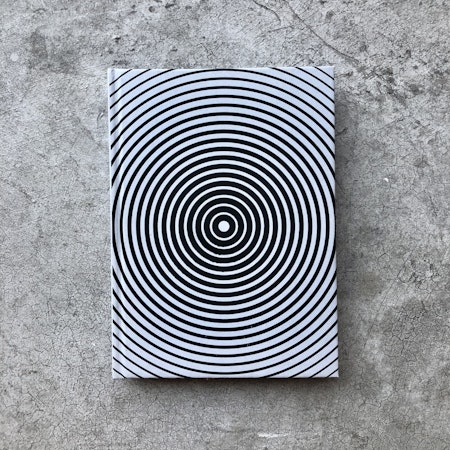Perhaps it is more essentially a characteristic of art, in this age when large quantities of complex information can be processed on the proverbial head of a pin, that it presents relatively small amounts of information while occupying a lot of social and physical space and time. If the technological acceleration of images and messages is promising to offer endless 'virtual realities' at our fingertips, it remains a general fact that we go out of our way to see art in a gallery or museum, and perhaps that is the point of it. For the poignancy of this attachment of artworks to a basic materiality as objects, is not a matter of mournful redundancy (as some might argue) but rather of the resistance they offer against the automatized barrage of substance-less detail or 'content' which saturates our cultural life.
However, the concrete and situational emphasis of Fusinato's art does not suggest an idealistic restitution of object to object, space to space, time to time, or color to colour as abstract absolutes. Common industrial and commercial materials are used, inferring an ambivalent, conflictual relationship with the day-to-day world outside. The viewer comes in off the street - just as the objects and materials of contemporary art have often come in off the street and gone out of their way. Fusinato reflects on the reality and spatial radiation of artworks, and upon the essential nature of what might be termed their 'art-ness'.
This exhibition consists of an improvised, informal ensemble of numerous red 'mono-chrome' paintings, some on the wall, painted on signwriters' steel, others painted on masonite panels and propped against the wall. The works have an uncompromising quality of sameness, which somewhat impedes commentary by the written word; such reflection normally depends very much on the apprehension of differences. Only an experiment (i.e. an exhibition) shows that the work actually works - because the artwork as an object, in spite of its 'paint is paint' materiality is not the object or end product of the exercise. It must communicate something about itself; what you see is never enough. Art always explains itself through art (i.e. which exists in situ between the viewer and the artwork) and Fusinato has always aimed at generating simple and self-sufficient expressions of art that are both sensually perceivable and intuitive.
Which is not to say that, because it is self-contained and reflexive, this work is 'empty' of meaning. On the contrary, the exhibit ensemble seems like a store-room stacked with art energy: i.e. with 'art-ness'. This content/energy is summed up with the visual statement of one colour, red - a color so loaded with meanings that it would seem pointless to tie to it any particular significance, as though it merely belonged to an inventory of signs and symbols. While interpretations may thus be unnecessary, they are by no means closed off; the colour's usual associations with ideas of energy and action are appropriate enough. Here the artist has applied red enamel to portable surfaces made for a gallery/museum context, but might equally apply the same red to any surface in any other context, with the same simplicity of statement.
The flat planes of Fusinato's paintings are antithetical to the idea of 'windows'. They are placed vertically or near-vertically in such a way as to suggest display as their purpose, but have nothing to do with problems of the configuration and the semiotics of images. It is also important to note that this concentration on simple and non-pictorial elements is unrelated to the logic of reductive positivism, mostly associated with so-called Minimalist art, whereby a monochrome painting would supposedly be arrived at through paring down the formal elements of the medium to 'purify' it. Such a total over-determination by the intellectual claims of art theory could hardly be further from the sensibility which is manifested in Fusinato's work. Equally this work seems antipathetic to the deconstructivist attitudes of postmodernism or the perceived need to critique ‘high’ modernist abstraction through its ironic simulation.
Fusinato's work is not about the rhetoric of abstraction, but an existential engagement with reality. When discussing his work, the artist insists on its being a kind of realism. The term realism, as used in art history or philosophy, for example, needless to say involves highly complex questions, and historically tends to be associated with an aesthetic tradition which sees art as mimesis, an imitation of life. Yet perhaps there is a contemporary, artistic disposition which can be termed as 'realism' because it concerns the relationship between art and the real world. This kind of realism expresses, moreover, a conviction that there is a real world - that 'reality' exists (an unfashionable notion in some theoretical circles). The realism of Marco Fusinato's art does not reflect a single reality that can be thought of as 'out there' and given once and for all, however, but rather concerns generations of reality; it works in addition to reality and, in itself, as an elementary generation of reality.

